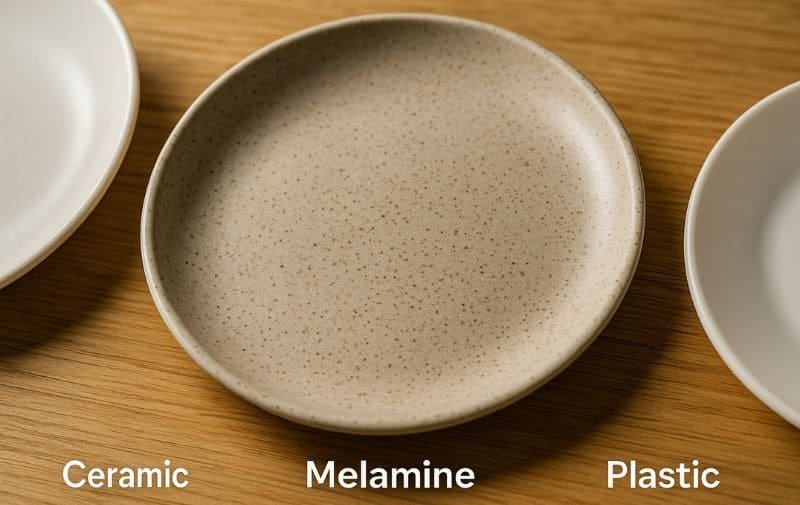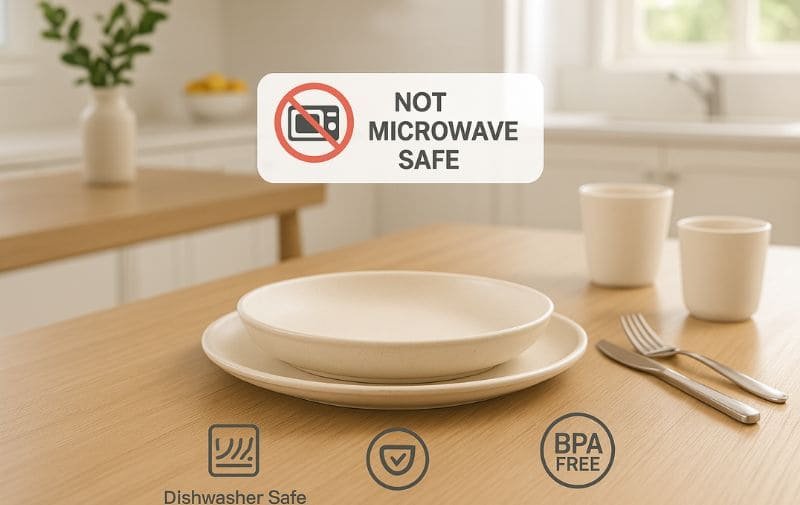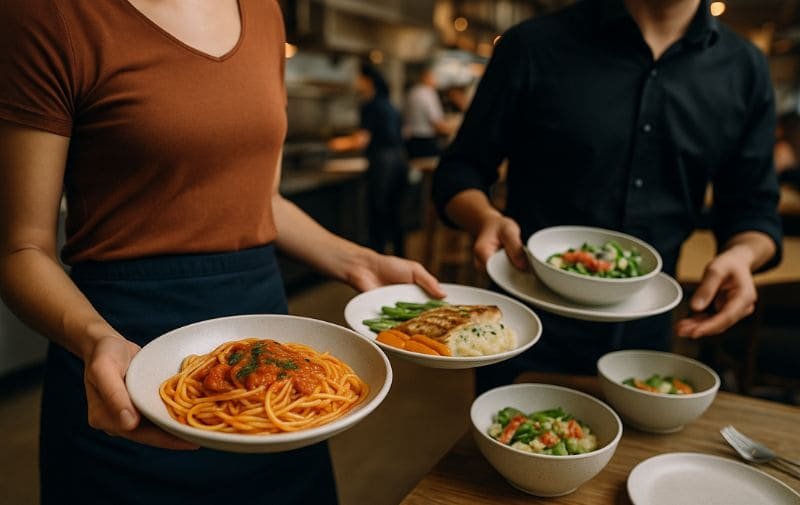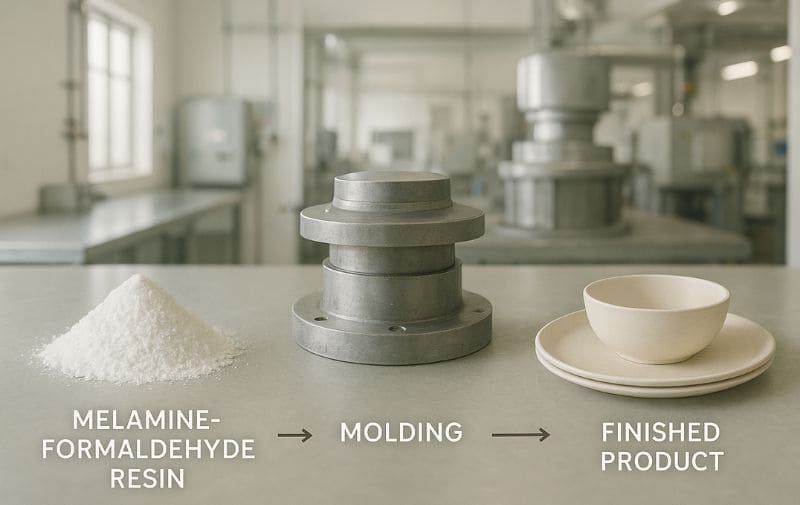You’re out to eat, and the plate feels solid and heavy, almost like fine ceramic. But it’s also incredibly light and doesn’t seem like it would chip easily. You wonder what this magical material is. Then you hear the name “melamine” and a question pops into your head: is it even safe?
Melamine dinnerware is a durable, thermosetting plastic, not ceramic. It is widely considered safe for serving food by global agencies like the FDA, provided it is 100% A5 grade melamine. Its one critical rule is that it must never be used in a microwave.
That’s the short answer, but the world of melamine is more complex than a simple “yes” or “no.” As someone who specifies tableware for businesses every day, I’ve had to become an expert in separating fact from fiction. Let’s dive deep into what melamine really is, why restaurants love it, and how you can be sure you’re using it safely.
Last Updated: July 25th. 2025 | Estimated Reading Time: 9 Minutes

What is Melamine? More Than Just Plastic
Let’s clear this up first: melamine is not a type of ceramic. It’s a plastic, but a very special kind.
Melamine is a hard, thermosetting plastic made from melamine resin. “Thermosetting” means that once it is molded, it is permanently set and cannot be melted or reshaped, which is what gives it its rigidity and durability.
Think of it like baking a cake. Once the ingredients are mixed and baked, you can’t turn the finished cake back into liquid batter. Melamine is made in a similar way. Melamine powder is placed into a mold, and under immense heat and pressure, it undergoes a chemical reaction that cures it into a solid, permanent shape. This process is why it feels much more rigid and substantial than common household plastics like Tupperware.
Thermoset vs. Thermoplastic: A Simple Breakdown
Understanding this difference is key to understanding melamine’s properties.
| Plastic Type | How It Behaves with Heat | Example | Key Feature |
|---|---|---|---|
| Thermoset Plastic | Cures and hardens permanently when heated. Cannot be re-melted. | Melamine, Bakelite | Rigid, Strong, Heat-Resistant |
| Thermoplastic | Softens when heated and hardens when cooled. Can be re-melted and reshaped. | Polypropylene (PP), PET | Flexible, Recyclable (by melting) |
This thermosetting nature is what gives melamine its ceramic-like hardness and feel.
The Most Important Question: Is Melamine Dinnerware Safe?
This is the biggest concern for most buyers, often revolving around the mention of formaldehyde. Let’s address this directly and scientifically.
Yes, 100% A5 food-grade melamine is safe for serving food. Global food safety authorities, including the U.S. FDA, have concluded that the chemicals in the finished product are locked in and do not migrate into food in any significant amount, as long as it’s used correctly.
Safety, however, is contingent on two crucial factors: quality grade and temperature.
The Golden Rule: Temperature is Everything
The one, non-negotiable rule for all melamine dinnerware is: DO NOT put it in the microwave.
The thermoset material, while stable for serving hot food, was not designed to withstand the extreme, direct heat of a microwave. Microwaving melamine can cause the material to break down over time, potentially leading to chemical migration and damaging the integrity of the plate itself.
| Usage Scenario | Is it Safe? | Why? |
|---|---|---|
| Serving hot food (soup, pasta) | ✅ Yes | A5 melamine is stable for serving food up to 212°F / 100°C (the boiling point of water). |
| Putting in the dishwasher | ✅ Yes | Standard dishwasher temperatures are well within the safe range for A5 melamine. |
| Putting in the microwave | ❌ NO | Microwaves can superheat the material itself, causing it to degrade, warp, and potentially leach chemicals. |
| Putting in a conventional oven | ❌ NO | Oven temperatures will cause the material to break down and should be avoided completely. |
Not All Melamine is Equal: Why A5 Grade is Everything
This is the most critical piece of insider knowledge you need when buying melamine. If you see a melamine plate that is shockingly cheap, there’s a reason for it, and it’s not a good one.
The term “melamine” can refer to different grades, but only A5 is 100% pure, food-grade melamine resin. Lower grades, like A1 or A3, are mixed with cheaper materials like urea and are not considered safe for tableware.

As a buyer, you must be able to distinguish between them to ensure safety and quality.
| Feature | A5 Melamine (100% Melamine) | A1 Melamine |
|---|---|---|
| Composition | 100% pure melamine-formaldehyde resin | 30% melamine resin, 70% urea-formaldehyde or other additives |
| Food Safety | Food-Grade Certified (FDA, LFGB, EU) | Not safe for hot food contact |
| Heat Resistance | Up to 212°F / 100°C | Up to 158°F / 70°C |
| Durability | Excellent; high gloss and hardness | Poor; brittle, prone to chipping and staining |
| Appearance | Smooth, glossy, ceramic-like finish | Dull, rougher texture, feels cheap |
| Best For | All food use: restaurants, homes, hotels | Non-food items like ashtrays, industrial trays |
| Relative Cost | Higher | Lower |
How Can You Ensure You’re Buying A5 Quality?
As a buyer, you must be proactive to avoid low-quality, unsafe imitations.
- Ask the Supplier Directly: Reputable manufacturers will proudly state they use 100% A5 grade material. Ask for it by name.
- Request Certifications: Demand to see food-grade safety reports, such as FDA, LFGB (German standard), or EU No. 10/2011. This is non-negotiable for any commercial purchase.
- Check the Product: High-quality A5 melamine feels dense, smooth, and has a high-gloss finish. Low-grade A1/A3 feels lighter, looks dull, and may have a rougher texture.
- Be Wary of Price: If a price seems too good to be true, it likely is. A5 raw material is significantly more expensive than urea-based fillers, and this will be reflected in the final product cost.
What Makes Melamine a Restaurant Favorite?
Walk into almost any high-volume casual restaurant, hotel buffet, or corporate cafeteria, and you will find melamine dinnerware. There are clear operational reasons why it’s the industry workhorse.
Melamine’s popularity in foodservice stems from its unique combination of extreme durability, light weight for easy service, and endless design possibilities, offering the look of ceramic without the high cost of breakage.
1. Superior Durability: Is Melamine Breakable?
While not completely unbreakable, A5 melamine is highly break-resistant. It can withstand the drops, bumps, and rough handling of a commercial kitchen that would shatter a ceramic plate instantly. This dramatically reduces replacement costs over time.
2. Lightweight and Easy to Handle
A stack of 10 melamine plates weighs a fraction of a stack of 10 ceramic plates. This is a huge operational advantage for serving staff, reducing physical strain and allowing them to carry more plates at once, which improves service speed.
3. Unmatched Design Versatility
Melamine can be produced in a virtually endless array of colors, shapes, and patterns.
- How Designs are Applied: Custom patterns, logos, and intricate designs are printed onto a special decal paper. This decal is placed on the plate during the molding process. Under immense heat and pressure, the decal fuses permanently with the plate and is sealed under a final, clear glazing layer. This ensures the design won’t peel, fade, or scratch off with normal use.
Pro Tip: This decal application process allows restaurants to have fully customized dinnerware with their branding, something that is prohibitively expensive to do with ceramic.
What are the Disadvantages of Using Melamine?
While it has many strengths, melamine is not a perfect material. It has two main weaknesses that you must be aware of.
The primary disadvantages of melamine are its absolute incompatibility with microwaves and its susceptibility to staining and scratching over time with heavy use of serrated knives and abrasive cleaners.

The Absolute “No Microwave” Rule
I cannot stress this enough. Microwaving melamine doesn’t just damage the plate; it makes it unsafe. The melamine resin absorbs the microwave energy, causing it to become extremely hot. This can lead to warping, blistering, and cracking. More importantly, this overheating can cause the chemicals in the resin to break down and migrate into your food. The rule is simple: Melamine is for serving, not for heating.
Staining and Scratching
While high-quality A5 melamine has excellent surface hardness, it’s not invincible.
- Stains: Over a long period, dark liquids like coffee and tea or highly pigmented foods like tomato sauce can leave faint stains, especially if left sitting for hours.
- Scratches: The surface can be scratched by serrated knives, like steak knives. Using smooth-edged knives is recommended. Aggressive, abrasive scouring pads can also dull the glossy finish over time.
The Banned Hybrid: A Warning About “Bamboo Melamine”
In recent years, a product called “bamboo melamine” or “bamboo fiber” dinnerware has appeared, marketed as a more “eco-friendly” option. This is a composite material made by mixing bamboo powder, corn starch, and melamine resin.
CRITICAL WARNING: This material is banned for import and sale in the European Union and other regions.
Extensive testing revealed that the bond between the organic bamboo fibers and the melamine resin is unstable. When used with hot foods or liquids, these products were found to leach melamine and formaldehyde at levels far exceeding safe limits. For this reason, professional buyers and importers must avoid this specific composite material entirely to ensure compliance and consumer safety.

Conclusion: Is Melamine Dinnerware the Right Choice?
High-quality, certified A5 melamine is an outstanding choice for any environment where durability, low replacement cost, and design versatility are top priorities. For the foodservice industry—restaurants, hotels, schools, and hospitals—it is often the smartest and most cost-effective option available. It provides the look and feel of ceramic without the constant worry and expense of breakage.
However, it is not a direct replacement for ceramic in every situation. If the ability to use your dinnerware in a microwave is a must-have, you should look to other materials.
By understanding the difference between high-grade A5 and its low-quality counterparts, and by respecting the “no microwave” rule, you can confidently leverage the incredible benefits of melamine dinnerware.
Frequently Asked Questions (F.A.Q.)
1. Why exactly can’t I put my melamine plate in the microwave?
The melamine resin is a thermoset material that absorbs microwave energy instead of letting it pass through to the food. This causes the plate itself to become extremely hot, which can break down the material’s stable structure. This can lead to warping, cracking, and potentially releasing chemicals, all while leaving your food lukewarm.
2. Is A5 melamine safe for serving very hot soup or coffee?
Absolutely. Certified A5 melamine is rated safe for continuous contact with food and liquids up to 212°F / 100°C. Since this is the boiling point of water, it is perfectly safe for serving fresh coffee, hot soups, and any other hot meal straight from the kitchen. The safety concern is with reheating in a microwave, not serving hot food.
3. How can I really tell if a plate is A5 melamine or a cheaper grade?
The most reliable way is to check the bottom of the plate. Reputable manufacturers often stamp “100% Melamine” or “A5” on the back. Beyond that, use your senses: A5 melamine has a satisfying density, a very smooth surface, and a high-gloss finish that looks like porcelain. Cheaper grades (A1/A3) often feel lighter, look dull, and may have a slightly rough or chalky texture.
4. What’s better for a busy restaurant: melamine or ceramic?
For most busy restaurants, melamine is the more practical and cost-effective choice. Its extreme durability dramatically cuts down on replacement costs from chipped or broken plates. Its lightweight nature also improves staff efficiency and reduces fatigue. While ceramic offers a certain classic heft, A5 melamine provides comparable aesthetics with far superior operational benefits.
5. Is melamine dinnerware safe for my kids to use?
Yes, A5 melamine is an excellent choice for children. Its primary benefit is being shatter-resistant, which prevents dangerous accidents with broken shards that can happen with ceramic or glass. It is also non-toxic and BPA-free, making it a safe and practical option for daily family meals.
6. I bought some melamine plates and the pattern is starting to wear off. Why?
This is a tell-tale sign of a low-quality product. In properly manufactured A5 melamine, the decorative decal is fused to the plate and sealed beneath a clear, protective glazing layer during the high-heat molding process. This permanent bond should not peel, flake, or wear off with normal use and dishwashing. A fading pattern indicates an inferior manufacturing process.



